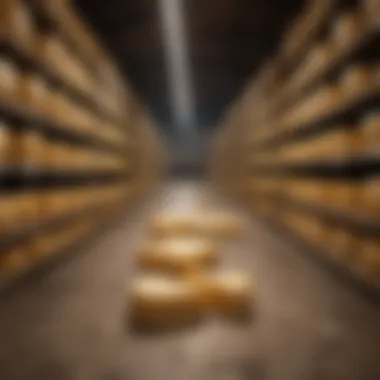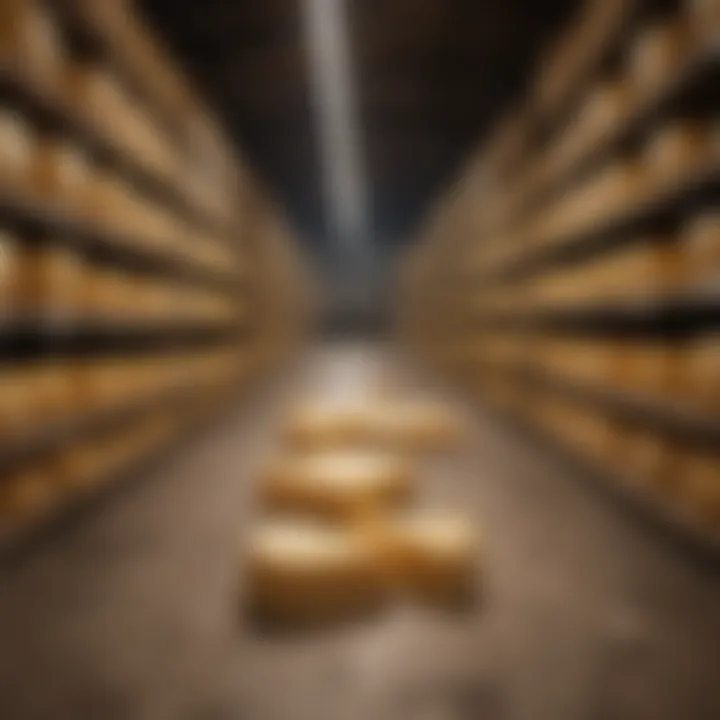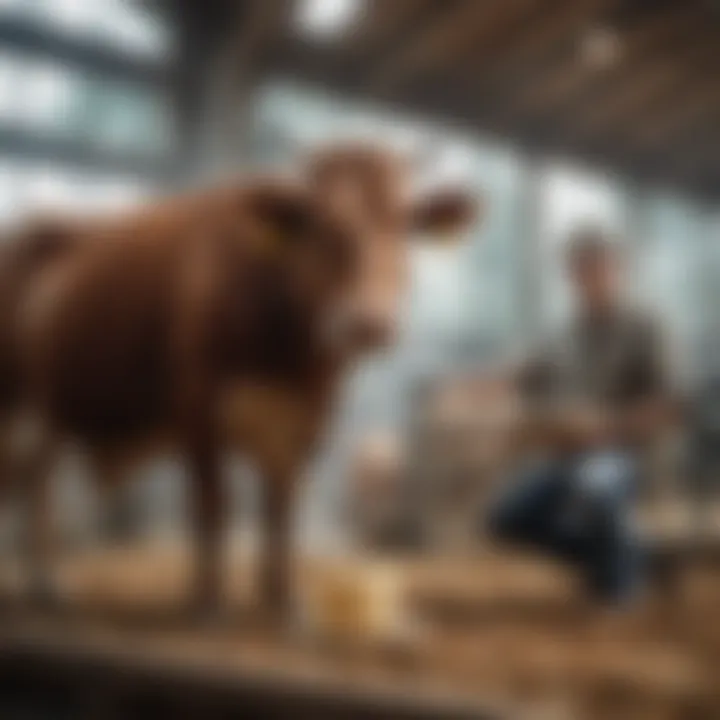Cheese Manufacturing Industry: Trends and Insights


Intro
The cheese manufacturing industry is a multifaceted sector with a rich history and complex processes. Understanding the evolution of cheese production is crucial for grasping its significance in food culture, nutrition, and economy. This narrative aims to explore the intricacies of cheese manufacturing, shedding light on various aspects such as production methods, market dynamics, and challenges faced by manufacturers.
Cheese, in its many forms, has global appeal. There are hundreds of varieties, each with distinct flavors, textures, and methods of production. Many of these are influenced by regional practices, climate, and available resources. In recent years, sustainability has become a critical theme within the industry, prompting producers to adapt their practices to meet both consumer demand and environmental standards.
This article will provide a comprehensive overview of the cheese manufacturing industry, making it informative for students, researchers, educators, and industry professionals alike.
strong>Summary of Objectivesstrong>
To analyze the cheese manufacturing industry, the objectives are clear:
- Investigate historical development and production processes.
- Explore current market trends and challenges.
- Understand the impact of technology and sustainability practices.
- Examine consumer preferences and regulatory frameworks.
Through these lenses, the article aims to present a thorough view of the industry and its future.
strong>Importance of the Researchstrong>
Researching the cheese manufacturing industry is essential because:
- It holds insights into food production trends.
- It highlights the importance of sustainability in food industries.
- It informs stakeholders about regulatory requirements and market demands.
Understanding these factors supports informed decision-making for manufacturers and policy-makers in an evolving landscape.
Historical Background of Cheese Manufacturing
The historical background of cheese manufacturing provides critical insights into the evolution of the industry. Understanding how cheese has been made throughout centuries reveals the cultural significance and technological advancements that shaped its production. The journey from simple cheese-making techniques to industrialized processes reflects not only the changes in society but also agricultural practices and consumer demands. Recognizing this history allows stakeholders to appreciate traditional methods while embracing modern innovations.
Origin and Evolution
Cheese has its origins dating back thousands of years, likely emerging around 8000 BCE when domestication of sheep and goats began. Archeological findings suggest that early cheese-making utilized simple methods like curdling milk in stomach containers. As nomadic tribes settled, they refined these basic techniques according to local resources. Different regions developed their own unique cheese styles, influenced by climate, culture, and religious practices. One notable example is the ancient Egyptians, who not only consumed cheese but included it in their art. The Greeks and Romans expanded cheese varieties further, leading to the creation of well-known cheeses such as feta and pecorino.
The Middle Ages marked a significant period in cheese history. Monasteries became centers of cheese production, where monks honed their skills. This era saw the preservation of artisanal cheese-making techniques that are still valued today. In the 17th and 18th centuries, cheese-making began to professionalize. The Swiss developed emmental cheese, while the French popularized brie and camembert. During the 19th century, the industrial revolution brought about mechanization, which drastically changed production methods, making cheese more accessible and diverse.
Key Innovations throughout History
Throughout history, key innovations in cheese manufacturing have played an essential role in enhancing production quality and efficiency. Pasteurization, invented by Louis Pasteur in the 19th century, became a landmark development. This method reduces harmful bacteria in milk, leading to safer cheese products and longer shelf life.
In the 20th century, innovations such as rennet extraction provided consistency in the cheese-making process. Rennet, an enzyme that curdles milk, allows for better quality control. The introduction of new bacterial cultures also played a crucial role. These cultures enhance flavors and influence textures, leading to a variety of cheese profiles.
Automation entered the scene in recent decades, allowing large-scale manufacturers to produce cheese with minimal human intervention while ensuring higher standards. Modern technology also supports better tracking through the supply chain, improving cheese safety and quality. Today, as the industry adapts to shifts in consumer preferences towards artisanal and organic cheeses, the historical background remains vital in shaping contemporary production methods.
"Each phase of cheese manufacturing history reflects a broader narrative of human ingenuity and adaptation, culminating in the diverse cheese we enjoy today."
As cheese continues to evolve in response to modern challenges, its rich historical background serves as a foundation for exploring future possibilities.
Types of Cheese Produced Globally
The global cheese market is a complex and diverse landscape, showcasing a wide variety of cheeses with unique flavors, textures, and aromas. This diversity is important in understanding the dynamics of cheese manufacturing. Different types of cheese cater to varied consumer preferences and cultural tastes, allowing manufacturers to expand their market reach. Additionally, the classification of cheeses supports education and awareness among consumers and researchers alike.
Fresh Cheeses
Fresh cheeses play a fundamental role in the cheese world. These cheeses are defined by their high moisture content and distinct, clean flavors. Common examples include ricotta, mozzarella, and queso blanco. They are often consumed shortly after production without aging. The significance of fresh cheeses lies in their versatility and health benefits; they can be used in salads, desserts, or as standalone items. Furthermore, their relatively simple manufacturing process makes them accessible for small-scale producers, fostering local economies.
Aged Cheeses
Aged cheeses encompass a broad spectrum of flavors and textures, enhancing the culinary experience. Cheeses such as cheddar, gouda, and parmesan fall under this category. The aging process transforms the milk flavors into complex taste profiles. This section of the cheese market is essential for gourmet cooking and creates opportunities for pairing with various foods and beverages. Health-conscious consumers may also appreciate aged cheeses for their lower moisture content and potential probiotic benefits.
Specialty Cheeses
Specialty cheeses are hailed for their unique characteristics, often made using traditional methods or with specific ingredients. Examples include blue cheese, goat cheese, and flavored varieties such as garlic or herbs. The importance of specialty cheeses cannot be overstated; they allow manufacturers to explore creativity and innovation in cheese production. These cheeses often carry a higher price point due to their artisanal nature. Moreover, they appeal to niche markets that prioritize quality and distinct flavors. \n
Specialty cheeses serve not only as culinary ingredients but also as cultural symbols representing regional identities and traditions.


Consumers increasingly seek out unique and diverse cheese options, shaping market trends. The variety in cheese types reflects broader shifts towards personalization and gourmet experiences within the food industry.
Production Processes in Cheese Manufacturing
The production processes in cheese manufacturing are critical to ensuring the quality and consistency of cheese products. Each step not only influences the flavor and texture of the final product but also plays a role in food safety and compliance with industry standards. Understanding these processes is essential for stakeholders in the industry, including manufacturers, regulators, and consumers.
Milk Selection and Quality Control
Milk is the foundational ingredient in cheese making. The quality of the milk directly affects the taste and characteristics of the cheese produced. Manufacturers must ensure that they select high-quality milk from reliable sources. This means working closely with dairy farms to implement strict guidelines.
Quality control measures often involve testing milk for:
- Bacterial content
- Fat content
- Protein levels
These factors are important because they influence the coagulation process. Moreover, any contaminants can lead to food safety issues. Therefore, constant monitoring and testing are crucial before milk is processed further.
Pasteurization and Standardization
Pasteurization is a process that heats milk to kill harmful bacteria and pathogens. This step is vital for ensuring food safety. It also impacts the flavor and shelf-life of cheese. Different cheeses require different pasteurization methods, ranging from quick heating to longer, slower methods.
Standardization refers to adjusting the fat content of milk before cheese production. This is necessary because different types of cheese have specific fat content requirements. For instance, mozzarella requires higher fat than cottage cheese. Standardization ensures that the cheese produced meets these requirements, allowing for consistency and quality in products.
Coagulation Techniques
Coagulation is the process that transforms liquid milk into solid curds. Manufacturers usually add rennet, an enzyme, to milk to start coagulation. There are different methods of coagulation, including:
- Traditional coagulation: Uses animal rennet and is common in many artisanal cheeses.
- Vegetable coagulants: Used for vegan cheese options.
Each technique yields varying textures and flavors. For instance, using different coagulants can affect the moisture level in cheese. Additionally, timing during coagulation is crucial as it influences the final product.
Aging and Ripening Processes
Aging is a significant step that gives cheese its unique character and depth of flavor. The process can vary widely by type of cheese. Aging can take from a few days to several years, depending on the desired outcome. Factors influencing aging include:
- Temperature
- Humidity
- Type of environment (such as caves or climate-controlled rooms)
During aging, beneficial bacteria and molds develop, influencing flavor and texture. For instance, aged cheddar develops sharper flavors over time, while fresh queso blanco remains mild and creamy. Therefore, understanding these processes is essential for any cheese manufacturer aiming to produce high-quality products.
"The process of cheese production is a delicate balance that brings science and art together. Each decision impacts the final taste and texture, underlining the need for precision in every step."
Efficient cheese production requires an in-depth understanding of these processes. Mastery over them will enable manufacturers to create a diverse range of cheeses that meet consumer preferences and market demands.
Market Trends and Consumer Preferences
Understanding market trends and consumer preferences is integral to the cheese manufacturing industry. This segment captures how shifts in consumer behavior impact production, marketing strategies, and ultimately the success of cheese manufacturers. Knowledge of these trends allows stakeholders to adapt effectively, ensuring they meet the evolving demands of an increasingly discerning market.
Growth of Artisan Cheese
The artisan cheese segment has gained traction during past years, driven by a desire for authentic, high-quality products. Consumers are showing a preference for cheeses that offer unique flavors, local sourcing, and traditional production methods. Unlike mass-produced alternatives, artisan cheeses often feature small batches and creativity, appealing to both snobbish tastes and sustainability-minded customers. The significance of this growth isn't just in numbers; it reflects a broader movement towards transparency in food production. The rise in farmer's markets and local shops often showcases these products, fostering personal connections between producers and consumers.
"Artisan cheese is not merely food; it is an experience that tells a story of place and process."
This trend challenges conventional large-scale production methods, encouraging innovation while supporting local economies. As people become more interested in how food is produced, manufacturers can leverage these sentiments to enhance market positioning.
Health Conscious Consumer Behavior
In parallel, there is a noticeable shift towards health-conscious eating, influencing cheese consumption patterns. As consumers become more aware of dietary impacts, there is an increasing demand for organic, low-fat, and probiotic-rich cheese options. Cheeses that provide health benefits, such as reduced sodium or added nutritional elements, are being marketed more effectively to the health-savvy population.
Consumers often scrutinize labels more closely than before, seeking out products that align with their values and nutritional goals. This awareness translates into willingness to invest in premium-priced cheeses that support a healthy lifestyle. Consequently, manufacturers need to focus on product development while ensuring transparent labeling practices to maintain trust with consumers.
Emerging Markets for Cheese Products
Emerging markets present notable opportunities for cheese manufacturers. Countries like China and India are experiencing shifting diets and growing middle-class populations. As these markets become increasingly open to dairy consumption, there is a significant potential for cheese products, particularly processed and ready-to-eat options. The growing trend of western culinary influences facilitates acceptance and diversification of cheese types in these regions.


Moreover, global trade agreements and advancements in cold chain logistics enhance the ability of manufacturers to enter new geographic markets. Companies looking to capitalize on these shifts should consider localized marketing strategies to effectively engage with new consumers accustomed to different food traditions.
The cheese industry is at a crucial junction, driven by the demands of an aware consumer base that values quality, health, and sustainability. By staying attuned to these trends, cheese manufacturers can adjust their practices strategically to enhance both brand loyalty and market growth.
Technological Advancements in Cheese Production
Technological advancements significantly transform cheese production. These innovations increase efficiency and ensure product quality, ultimately benefiting both producers and consumers. The integration of modern technology is essential for manufacturers striving to meet high standards and consumer demands. These advancements not only streamline processes but also enhance the safety and sustainability of cheese products.
Automation in Manufacturing
Automation in cheese manufacturing plays a pivotal role in optimizing production. This technology involves utilizing machines and software to handle various tasks, reducing the need for intensive manual labor. Automation ensures consistent product quality by regulating temperature, humidity, and other variables during the production process. It can also increase production speed, enabling manufacturers to meet expanding market demands.
Moreover, automation minimizes human error, which can lead to variations in flavor and texture. Manufacturers can maintain strict adherence to recipes and specifications, ensuring that every batch meets the high standards expected by consumers. The implementation of automated systems often leads to cost savings in the long term, as reduced labor costs can offset the initial investment in technology.
Role of Biotechnology
Biotechnology has become a cornerstone of modern cheese production. This field applies biological processes to develop new methods for cheese making, improving flavor profiles and extending shelf life. One notable application is the use of genetically modified microorganisms, which can enhance fermentation processes. These modifications can result in cheeses with unique characteristics and enhanced flavors.
Additionally, biotechnology allows for better quality control. It enables producers to monitor microbial activity closely, ensuring safety and consistency. The use of enzymes derived through biotechnological methods can also improve texture, leading to more appealing final products. Furthermore, this technology can help in producing cheese varieties that cater to specific dietary needs, like lactose-free options.
"Biotechnology in cheese production not only allows for innovation but also meets diverse consumer preferences, enhancing satisfaction across demographics."
In summary, both automation and biotechnology are crucial in driving advancements in cheese manufacturing. These technologies not only create efficiencies but also ensure the production of high-quality cheese that meets the evolving tastes and safety requirements of consumers.
Sustainability in Cheese Manufacturing
Sustainability in cheese manufacturing has become an essential topic in recent years. As consumers grow increasingly aware of the environmental implications of their food choices, cheese producers are compelled to adopt practices that minimize their ecological footprint. Sustainability encompasses a wide range of elements, including resource management, waste reduction, and ethical sourcing of ingredients. The transition towards sustainable practices not only benefits the environment but also caters to an evolving consumer base that values responsibility and transparency.
Environmental Impact Analysis
The environmental impact of cheese manufacturing primarily stems from agricultural practices, water usage, and energy consumption. Dairy farming often involves significant land use, greenhouse gas emissions, and water-intensive operations. For instance, dairy cows produce methane, a potent greenhouse gas, adding to climate change concerns.
The analysis of this environmental footprint involves assessing:
- Land Use: The space required for dairy farming can lead to deforestation and habitat disruption. Choosing sustainable feed sources is important to mitigate this.
- Water Consumption: Cheese production requires large amounts of water, both for raising livestock and for the production process itself. Effective water management practices are critical.
- Energy Use: Energy consumption during production and transportation contributes to carbon emissions. Transitioning to renewable energy sources can alleviate these concerns.
By analyzing these areas, cheese manufacturers can identify opportunities for improvement. They can then implement measures to assess their impact and adopt strategies that promote sustainability.
Sustainable Practices Adopted by Manufacturers
Given the pressing need for sustainable practices, many cheese manufacturers have taken proactive steps to minimize their environmental impact. Some of these practices include:
- Sourcing Local Ingredients: By sourcing milk and other ingredients locally, producers can reduce transportation emissions and support local economies.
- Implementing Recycling Programs: Many companies have adopted recycling and waste reduction programs that decrease waste produced during manufacturing.
- Utilizing Renewable Energy: Solar panels and wind energy solutions are increasingly being utilized to power cheese production facilities, thereby reducing dependence on fossil fuels.
- Animal Welfare Standards: Ethical treatment of animals is another aspect of sustainability. Adhering to strict animal welfare guidelines ensures better quality of life for livestock, which indirectly leads to better quality milk.
"Sustainability is not just a trend; it is a fundamental shift in how we approach cheese production and its impact on the environment."
- Consumer Engagement: Educating consumers about the importance of sustainable practices enhances brand loyalty. Producers can engage customers through transparent marketing and traceability.
Regulatory Landscape for Cheese Production
The regulatory landscape for cheese production is crucial for ensuring the safety and quality of cheese products. These regulations are designed to protect consumers, facilitate fair competition, and maintain public health. They cover various aspects, from sourcing raw materials to distribution and sale of cheese. Understanding these regulations is essential for manufacturers, as compliance is not just a legal obligation but a way to foster trust with consumers.
With the growth of the cheese market, regulatory frameworks have adapted to address emerging challenges, including food safety concerns and the need for transparency in food labeling. Therefore, manufacturers must stay abreast of these evolving standards to align their operations and products with legal requirements. This involves continuous education about the standards set by relevant authorities such as the Food and Drug Administration (FDA) in the United States and similar organizations worldwide.
"Adhering to regulatory requirements not only ensures compliance but also enhances product integrity and consumer confidence."
Successful navigation of the regulatory landscape involves recognizing the implications these laws have on production practices and product development. This allows cheese manufacturers to optimize their operations while ensuring compliance, which ultimately impacts their brand reputation and market presence.
Food Safety Standards
Food safety standards are among the most significant regulations impacting cheese production. These standards are put in place to minimize the risk of contamination and ensure that products are safe for consumption. Manufacturers must implement strict hygiene protocols during handling, processing, and storage of cheese.
Key components of food safety standards include:
- Microbial control: Regular testing for pathogens like Listeria and Salmonella is necessary
- Temperature control: Maintaining specific temperatures during aging and storage is critical
- Employee training: Staff must be trained in food safety practices to reduce risks of contamination


Additionally, proper sanitation practices within facilities contribute significantly to compliance with food safety standards. Routine audits conducted by health departments or independent organizations help maintain oversight and ensure adherence to guidelines, which is critical in preventing foodborne illnesses.
Labeling Requirements
Labeling requirements for cheese products are an essential aspect of regulatory compliance. These requirements ensure that consumers receive accurate and comprehensive information about the products they buy. Accurate labeling helps promote transparency and informed choices.
Important features of labeling requirements include:
- Nutritional information: Labels must provide detailed nutritional content, allowing consumers to make health-conscious decisions.
- Ingredient listings: Clear identification of all ingredients is necessary to inform consumers, particularly those with allergies or dietary restrictions.
- Origin labeling: In many regions, labeling the country of origin is a requirement, helping consumers understand the sourcing of their food and supporting local producers.
Failure to comply with labeling requirements can lead to penalties and consumer backlash. Therefore, cheese manufacturers must collaborate with experienced regulatory advisors to ensure that their product labels meet all local and international regulations. This proactive approach not only safeguards against legal issues but also enhances consumer trust in the brand.
Challenges in the Cheese Manufacturing Industry
The cheese manufacturing industry faces several challenges that can significantly impact production efficiency, market dynamics, and consumer satisfaction. Understanding these challenges is crucial for industry stakeholders. Key elements include supply chain disruptions, competition levels, and the necessity to adapt to consumer preferences. Addressing these challenges is essential, as it not only ensures the sustainability of cheese production but also helps manufacturers innovate and maintain a competitive edge in a rapidly changing market.
Supply Chain Disruptions
Supply chain disruptions can arise from various factors such as natural disasters, political instability, or global pandemics. These interruptions affect the entire production process. For instance, the COVID-19 pandemic exposed many vulnerabilities in the supply chain. Dairy farmers struggled to maintain their operations while adhering to changing regulations and restrictions. Additionally,
- Transportation issues: Constraints in logistics can delay the distribution of raw materials like milk and packaging supplies.
- Market fluctuations: Variability in demand can lead to overproduction or underproduction, complicating inventory management.
These disruptions necessitate robust contingency planning. Adopting technologies such as blockchain can enhance traceability and support better inventory management. In this way, the industry can minimize the impact of supply chain interruptions, ensuring consistent production levels.
Competition and Market Saturation
As the cheese market grows, so does the competition among cheese manufacturers. Numerous brands and artisanal producers introduce diverse cheese options, saturating the market. This situation can create challenges for established producers, which may struggle to maintain their market share. The competition is driven by:
- Differentiation in products: New entrants often focus on unique flavors, organic ingredients, or artisanal methods.
- Pricing pressures: With many products available, consumers tend to be price sensitive, forcing companies to engage in discounting or promotions.
To navigate this competitive landscape, manufacturers should focus on brand positioning and marketing strategies. This helps to articulate their value proposition effectively. Sustainable practices and transparency in production can also appeal to consumers who prioritize ethical consumption.
Adapting to Consumer Preferences
Consumer preferences shift quickly, influenced by trends in health and wellness, dietary restrictions, and cultural factors. Cheese producers must stay attuned to these changes to remain relevant. Keeping pace requires:
- Market research: Regularly assessing consumer behaviors is essential to understanding current demands.
- Product innovation: Developing new cheese varieties that align with health trends, such as lower-fat options or lactose-free products, can capture new consumer segments.
Moreover, educational efforts on cheese consumption, nutrition, and culinary uses can enhance consumer engagement. Manufacturers who invest in understanding and adapting to these preferences not only meet market demands but also build consumer loyalty.
In summary, proactively addressing supply chain issues, navigating competition, and adapting to evolving consumer preferences are vital for sustaining growth in the cheese manufacturing industry.
Future of Cheese Manufacturing
The future of cheese manufacturing stands at a crossroads of tradition and innovation. As the industry evolves, several key elements become crucial in shaping its direction. Understanding the anticipated trends and innovations, the effects of globalization, and the necessity for consumer education can foster a more resilient and adaptable sector. Each of these components influences not only production practices but also consumer engagement and market dynamics.
Predicted Trends and Innovations
The cheese industry is expected to embrace multiple innovations.
- Plant-Based Alternatives: With the rise in veganism and lactose intolerance, manufacturers are exploring plant-based cheese alternatives. Innovations in texture and flavor are critical to compete with traditional dairy products.
- Smart Production Techniques: Automation and AI technologies are likely to refine production processes, ensuring consistency and efficiency. This reduces waste and improves product quality, essential for meeting increasing consumer expectations.
- Sustainable Practices: The push for eco-friendly practices will spearhead new production techniques. Emphasizing resource conservation and reducing carbon footprints can resonate with environmentally conscious consumers.
As these trends manifest, they will redefine the landscape of cheese manufacturing, aligning it more closely with contemporary consumer values and technological capabilities.
Impact of Globalization
Globalization significantly influences the cheese manufacturing industry. As markets become more interconnected, several outcomes emerge:
- Diversity of Flavors: Consumers have access to a wider variety of cheeses from different cultures. This diversification promotes cross-cultural appreciation, which can enhance market demand.
- Competitive Pressures: Local manufacturers may face challenges from international imports. Competing with foreign cheeses necessitates a focus on quality, unique selling propositions, and understanding local consumer preferences.
- Collaborative Innovations: International partnerships can lead to shared knowledge and best practices in production. This collaboration can foster innovation and efficiency across borders.
In summary, globalization introduces both opportunities and challenges. Manufacturers must strategically navigate these shifts to remain relevant.
Consumer Education on Cheese Products
As the cheese market grows and diversifies, consumer education becomes paramount. A more informed consumer base can influence not only purchasing behavior but also the industry's approach to marketing and production.
- Understanding Types of Cheese: Educating consumers on the different types of cheese, such as fresh, aged, and specialty varieties, can enhance their appreciation and enjoyment.
- Health Benefits and Risks: Providing clear information about nutritional values, health benefits, and potential allergens is essential. Transparency can build trust and loyalty.
- Sustainable Choices: Consumers increasingly seek products from brands that prioritize sustainability. Educating them on eco-friendly practices empowers them to make informed choices.
"The future of cheese manufacturing will hinge on the industry's ability to adapt to consumers' evolving preferences and the complexities of globalization."















